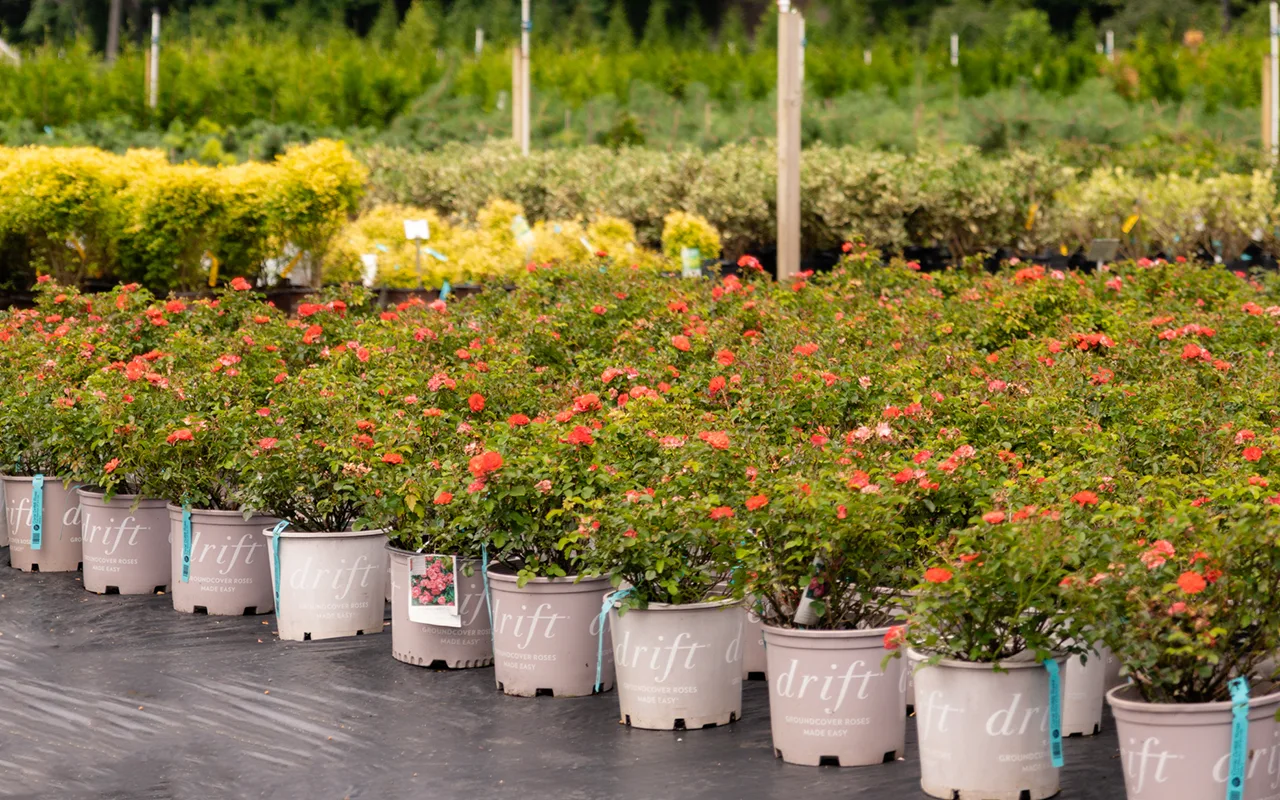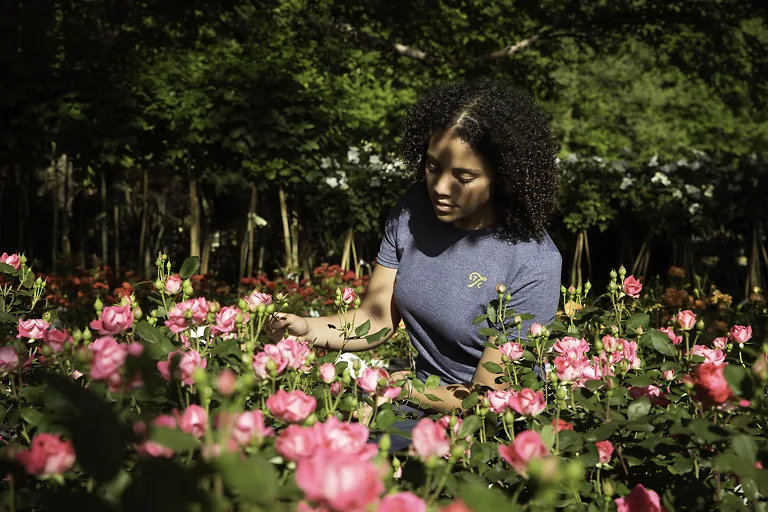
Written by s • How Are Roses Propagated?
When you first start growing plants in your garden, how they are produced is often of no concern – getting them to grow is always the first priority. It doesn’t take long, though, before more adventurous gardeners start growing some plants from a colorful seed packet, or putting some pieces of Busy Lizzie (Impatiens) in a glass of water and seeing roots form. Since these are the easiest and most widely-known ways of growing more plants, it’s only natural to think that all plants are grown this way. If that was true the life of nursery workers would be easy, but things are more complicated – just like life itself. So let’s ask a simply question – with around 60 million roses bushes sold every year, how are they all produced?
This isn’t just an idle question, because some strange things can happen with the bushes in your garden, and knowing how they have been grown will often help solve problems like – what do I do with that crazy-looking long shoot sprouting from my rose bush – do I keep it or cut it off?
Roses from Seeds
Yes, roses can be grown from seeds – and certain ones are, in large numbers. But, if you are thinking of growing the seeds in that fat rose-hip that has formed on your favorite bush, the result may not be what you are expecting. It certainly won’t be a copy of that rose, and is likely to be very different indeed. Better? Well, maybe, but if you consider that a rose breeder grows thousands of seedlings to find just one worthwhile new variety, then the odds are definitely against you. It’s the same reason your kids are not perfect copies of you – good old genetics and sexual re-arranging (although hopefully the ‘not better’ doesn’t apply!). This is also true for many highly-bred plants, including fruit trees, and it’s why sowing those lemon pips, avocados or apple seeds, is not only going to be a very long wait, but the result will almost certainly be stunningly disappointing. Unless you buy a wild species, the plant you buy has certainly been grown from a seed – once – but then reproduced ‘vegetatively’ from the single, selected individual, but the plant you have is not a seedling.
Roses from Budding
Many people talk about roses being ‘grafted’, but that isn’t strictly true. Almost all commercial nursery plants are propagated by a special kind of grafting called ‘budding’.
Grafting is joining two genetically different plants together. Often they are the same species – apple trees for example – but they are also often two related species. A graft uses a small branch – called the scion – attached to the lower stem of a plant with roots – the rootstock. In budding the scion is reduced to a single bud that is removed from a stem of the scion and tucked under a flap of bark on the rootstock. This is usually done is spring, in a short window when the sap is running in the bark and it can easily be separated to make the flap. Growers say that the ‘bark is slipping’.
The main advantage of budding over grafting is that one piece that would form a graft scion can give 4 to 8 buds. Since a nursery must keep a supply of plants of each plant it wants to propagate, with budding they need a lot fewer plants of each variety for this. Less space needed and fewer plants to care for means reduced costs overall.
The broader reasons for choosing budding over other methods is uniformity – one technique for every plant they have, done at the same time of year, with the same results. This make mass-production much easier than adapting and learning how each plant is going to perform with other techniques.. Plus, especially for classic hybrid tea and floribunda roses, the plants are more vigorous, more uniform for group planting, and produce more flowers – even in some cases with better colors.
The choice of what exact rose to use for rootstock varies from place to place, and even from nursery to nursery. However, in America it is relatively uniform, and most roses are budded onto a rose called ‘Dr. Huey’. This is a vigorous climbing rose created over 100 years ago, with deep-red flowers and stems that are almost thornless. It can grow to 20 feet long very quickly. Pieces of the stem root easily from cuttings, which is how the rootstocks are created, and the rapid growth of this plant means it is easy to produce thousands of cuttings to root, and thousands of rootstocks. For tree roses the cutting is 38 inches long, and when rooted creates a 36-inch trunk for the rose tree.
The lack of thorns makes them easier to work with, and makes it easier to see that a shoot coming up is not the rose you want. It has a relatively long period in spring when it can accept the bud. It grows easily in different soils and different areas, and especially well in California, where 80% of roses are produced.
In colder climates, like Oregon and Canada, growers may use another vigorous rose, Rosa multiflora, as it is more cold-resistant. In Europe growers tend to favor the dog-rose, Rosa canina, which suits the climate better.
For a gardener, the only problem with budded roses is the tendency of the rootstock to send up shoots, which because they are so vigorous, soon take over and smother the rose you want – and surrounding plants too! These are called ‘suckers’, and can come from below ground, at ground level, or off the trunk of a rose tree. Look at the leaves of your rose, and if you see a stem that has different leaves, trace it back to see where it begins. Maybe it has no thorns, or they are different is size and shape from the ones on your rose. Remember that roses can also send up new, vigorous shoots from the bud area, so most strong new shoots will be your rose – don’t make a hasty judgement. Suckers are relatively rare events.
Once you are sure it is a sucker, cut it off flush with the stem, or dig down and cut it out underground. The more you take off, the less chance it will start to sprout again, so try not to leave a short stem behind or you will be forever cutting it.
Roses from Cuttings
Roses can also be grown from pieces of stem. This was how ordinary gardeners used to do it, but it was largely replaced in commercial nurseries by budding well over 100 years ago. In recent times some growers have turned to using it, especially for old-fashioned roses; varieties of the beach rose, Rosa rugosa; and miniature roses, too. Results can vary from variety to variety. Sometimes the plants will be vigorous and flower well, other times they are weaker, and don’t grow as well – it’s hard to predict. Experts and professionals argue about which way is best.
If you want to try your hand at growing roses from cuttings, check out our blog on it.
To find out if your plant is budded or grown from a cutting, look at the base of it. Does it have a stiff single stem coming out of the ground, with branches all growing from one point? Do those branches appear to come mostly from one side of the stem, and is there a flat area like a part has been cut off? If the answer is, “Yes”, to these questions, your rose is probably budded. If you have a tree rose, it is definitely budded. If there is no sign of a single stem, and you have numerous similar stems growing straight out of the ground, it is probably grown from a cutting.
If you have roses grown from cuttings, then of course you won’t have any problems from the suckers we talked about earlier – every stem will be the rose, even if it comes from below ground. However if a shoot grows up where the leaves do look very different, or it has no thorns, or very different-looking ones, then perhaps you were mistaken, and your plant is actually budded.
A Rose Made Any Way is Still Sweet
It’s helpful to know how your plants are produced, as it makes identifying any problems easier. It also makes gardening more interesting, knowing more of the story of your plants.







